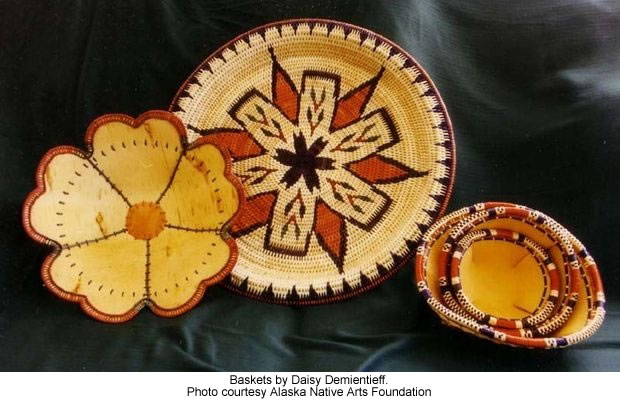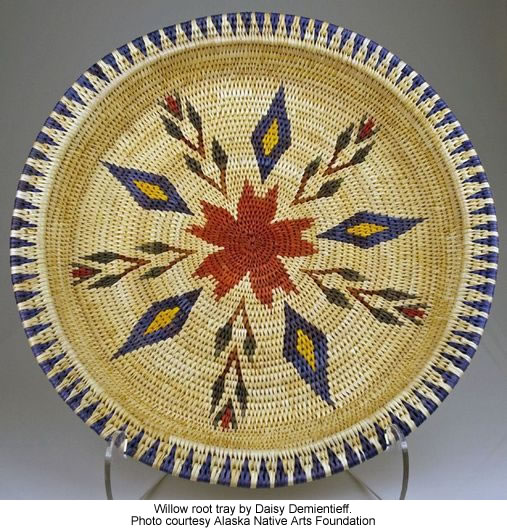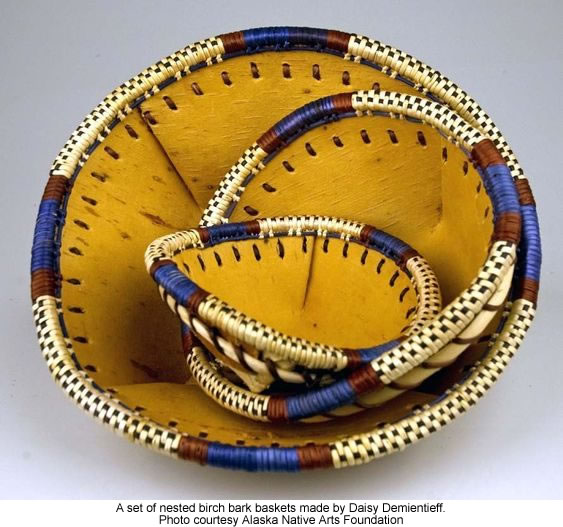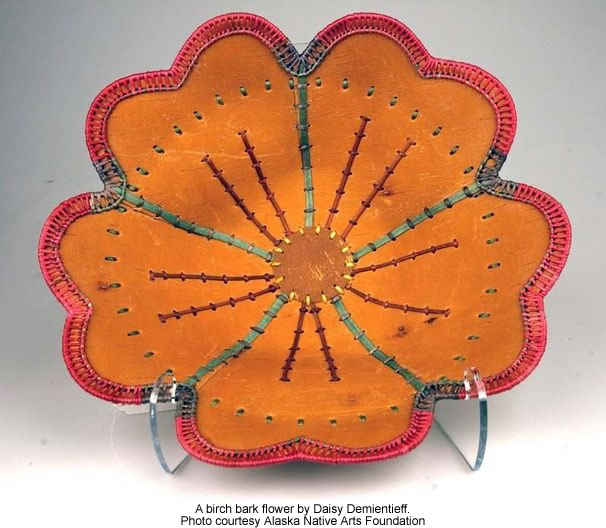 |
Canku Ota
|
 |
|
(Many Paths)
|
||
|
An Online Newsletter
Celebrating Native America
|
||
|
November 1, 2009 - Volume
7 Number 11
|
||
|
|
||
|
Weaving With Wood
|
||
|
by Mike Dunham - Anchorage
(AK) Daily News
|
||
|
She thought the same thing, she said. And she was wrong. "When I left home, I had this idea that anytime I needed money, I'd just start right in and make a basket," she said. But when the time came and she tried to turn a tough willow root into the pliable fiber strand needed for weaving, the root cracked and broke off, becoming unusable for anything but kindling. "So I had to go back and learn it," she concluded with a philosophical sigh. In a recent documentary, "A Beautiful Journey," Demientieff shows the right way to do it -- and the process is not for the faint of heart. It begins with days of travel by boat on the Tanana and Yukon rivers, camping out in whatever conditions the country may throw at you -- mosquitoes, chill and rough, log-clogged water -- hunting for places where erosion has exposed roots suitable for the artistic medium. Length, thickness and viability of the root are all considerations to be carefully weighed at the time of picking. But no matter how carefully the initial selection is done, many of the harvested roots will have to be discarded later on. Once Demientieff spies a likely candidate, or cluster of candidates, things can get really tricky. With luck they can be pulled up from a more or less flat bar with relative ease. But they may also stick out from a cut bank that looms straight up from the river. In those cases, she and her crew of family and friends can find themselves teetering on the bow of the boat, leaning over the deep, cold water, straining to reach a prize root and giving it a tug. But not too hard a tug, lest hundreds of pounds of overhanging dirt and vegetation come crashing down on them.
In "A Beautiful Journey" she shows how she splits the roots. It's an exercise in careful leverage, counterbalanced pressures and brute force requiring both hands and good set of teeth. When
finished the split roots will be woven into large trays, an on-again-off-again
process that can take years. During the making, eye-catching geometric
patterns emerge. "The patterns aren't written down," Demientieff
confirmed. "You just start and see what happens."
Closer to home she has taught in Anchorage schools as part of the Artist-in-the-School program for many years and twice has been chosen as the Elder of the Year by Cook Inlet Region, Inc., the Native-owned corporation based in Anchorage, where she now lives. She recently had a solo exhibition at the Alaska Native Arts Foundation Gallery in Anchorage and is included in the "Weaving of Life" show at the Alaska House gallery in New York City, opening this month. In addition to the tedious split-root weaving, she also does widely admired birch bark baskets, bead work and skin sewing, "Fur things, mukluks, hats. I think Native women need to know these things," she said.
As "A Beautiful Journey" shows, she is actively engaged in teaching her skills to a new generation of Athabascan women. Also on the film is the sound -- though not any pictures -- of Demientieff making music. With her late husband Mike, who died in 2003, she was a fixture at the annual Athabascan Fiddle Festival in Fairbanks. She sings and plays guitar and was the festival's Honored Elder in 2005. But honors are secondary for her. She finds her real fulfilment in the work she produces. "It's my therapy," she said. "I don't want to clean house. I want to do bead work and make baskets."
|
|
insert map here
|
|
|
||
|
|
||
| Canku Ota is a free Newsletter celebrating Native America, its traditions and accomplishments . We do not provide subscriber or visitor names to anyone. Some articles presented in Canku Ota may contain copyright material. We have received appropriate permissions for republishing any articles. Material appearing here is distributed without profit or monetary gain to those who have expressed an interest. This is in accordance with Title 17 U.S.C. Section 107. | ||
|
Canku Ota is a copyright ©
2000, 2001, 2002, 2003, 2004, 2005, 2006, 2007, 2008, 2009 of Vicki
Barry and Paul Barry.
|
||
 |
 |
|
|
The "Canku
Ota - A Newsletter Celebrating Native America" web site and
its design is the
|
||
|
Copyright ©
1999, 2000, 2001, 2002, 2003, 2004, 2005,
2006, 2007, 2008, 2009 of Paul
C. Barry.
|
||
|
All Rights Reserved.
|
||
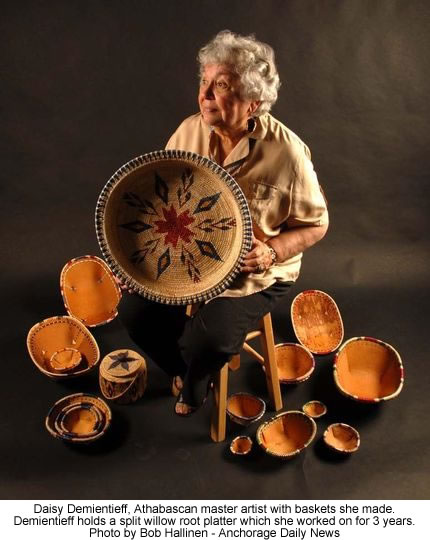 You
might think that making Athabascan split willow root trays and baskets
would be in Daisy Demientieff's blood. After all she was born in
a fish camp on the Yukon River, grew up in a log cabin speaking
the local Deg Xinag dialect, had ample opportunity to watch the
traditional craft work at which her mother and grandmother excelled.
You
might think that making Athabascan split willow root trays and baskets
would be in Daisy Demientieff's blood. After all she was born in
a fish camp on the Yukon River, grew up in a log cabin speaking
the local Deg Xinag dialect, had ample opportunity to watch the
traditional craft work at which her mother and grandmother excelled.